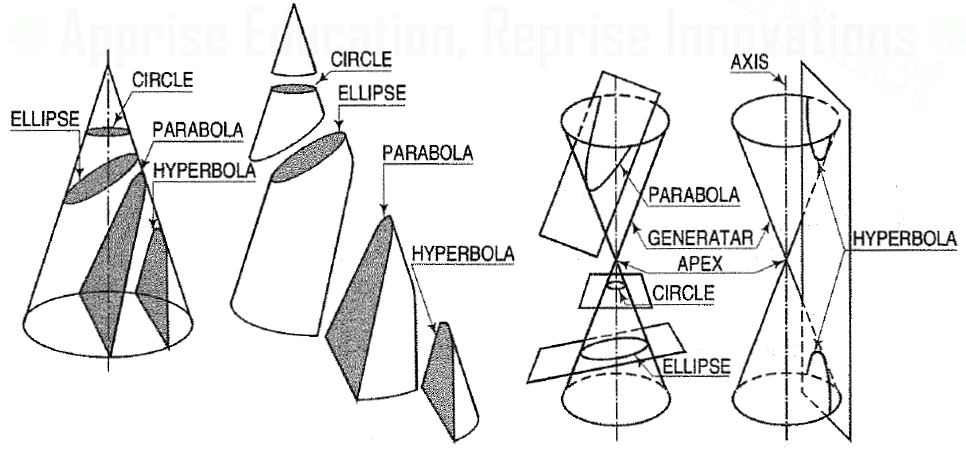UNIT 6
Engineering Curves
Curves used in engineering practice:
The profile of number of objects consists of various types of curves.
1. Conic sections:
The section obtained by intersection of a right circular cone by a plane in different positions relative to the axis of the cone are called conics.

Conic sections are always "smooth". More precisely, they never contain any inflection points. This is important for many applications, such as aerodynamics, civil engineering, mechanical engineering, etc.
The conic may be defined as the locus of a point in a plane, wherein the ratio of its distance from a fixed point and a fixed straight line is always constant. The fixed point is called the focus and the fixed line, the directrix.
The ratio  is called eccentricity and is denoted by ‘e’. It is always less the 1 for ellipse, equal to 1 for parabola and greater than 1 for hyperbola.
is called eccentricity and is denoted by ‘e’. It is always less the 1 for ellipse, equal to 1 for parabola and greater than 1 for hyperbola.
Ellipse:
Use of elliptical curves is made in arches, bridges, dams, monuments, man holes, etc. Mathematically an ellipse can be described by equation  .
.
Here ‘a’ and ‘b’ are half the length of major and minor axes of ellipse and x and y are co-ordinates.

Parabola:
Use of parabolic curves is made in arches, bridges, sound reflectors, light reflectors, etc. Mathematically it can be described by an equation  or
or  .
.
Involute:
The involute is a curve traced out by an end of a piece of thread unwound from a circle or a polygon, the thread being kept tight. It may also be defined as a curve traced out by a point in a straight line which rolls without slipping along a circle or a polygon.
It is used as teeth profile of gear wheel.
Mathematically it can be described as by  ,
,  , where “r” is the radius of the circle.
, where “r” is the radius of the circle.
Spiral:
If a line rotates in a plane about one of its ends and if at the same time, a point moves along the line continuously in one direction, the curve traced out by the moving point is called a spiral. The point about which the line rotates is called a pole.
The line joining any point on the curve with the pole is called the radius vector and the angle between this line and the line in its initial position is called the vectorial angle.
Archemedian spiral:
It is a curve traced out by a point moving in such a way that its movement towards and away from the pole is uniform with the increase of the vectorial angle from the starting line.
The use of this curve is made in teeth profiles of helical gears, profile of cams, etc.
HEXAGONAL HEADED BOLT
It is the most commonly used form of the bolt. The head of a hexagonal head bolt is a hexagonal prism with a conical chamfer rounded off at an angle of 30° on the outer end face. All dimensions of a hexagonal head bolt and hexagonal nut are same except the height or thickness of the hexagonal head. The approximate height/thickness of the bolt head is 0.8d (d is the diameter of the bolt). A little portion (about 3 mm) of the threaded end should remain outside the nut.

HEXAGONAL NUT
The most commonly used type of nut is the hexagonal nut. It is a hexagonal prism provided with a threaded hole. Upper corners of a nut are "chamfered" or "rounded- off". Chamfering is done to remove sharp corners to ensure the safety of the user. The angle of chamfer is usually "30° with the base of the nut". The chamfering gives arcs on the vertical faces of the nut and circle on the top surface of the nut. The chamfering circle on the top surface touches the mid points of all the side of the nut which can be seen in the top view.

SCREW THREAD
Screw threads are widely used for temporary fastening as well as for transmission of power from one machine parts to another
TERMS USED IN THREADS / SCREW THREADS
The various terms in connection with screw threads are given below

Reference:
- Engineering Drawing Dhananjay A.Jolhe Tata McGraw Hill Education.
- Engineering Drawing Basant Agarwal C.M Agarwal Tata McGraw Hill Education
- Engineering Drawing M.B.Shah, B.C. Rana Pearson Education, India
- A Text book of Engineering Graphics M.I. Dhabhade Association of Technical Authors, Pune.